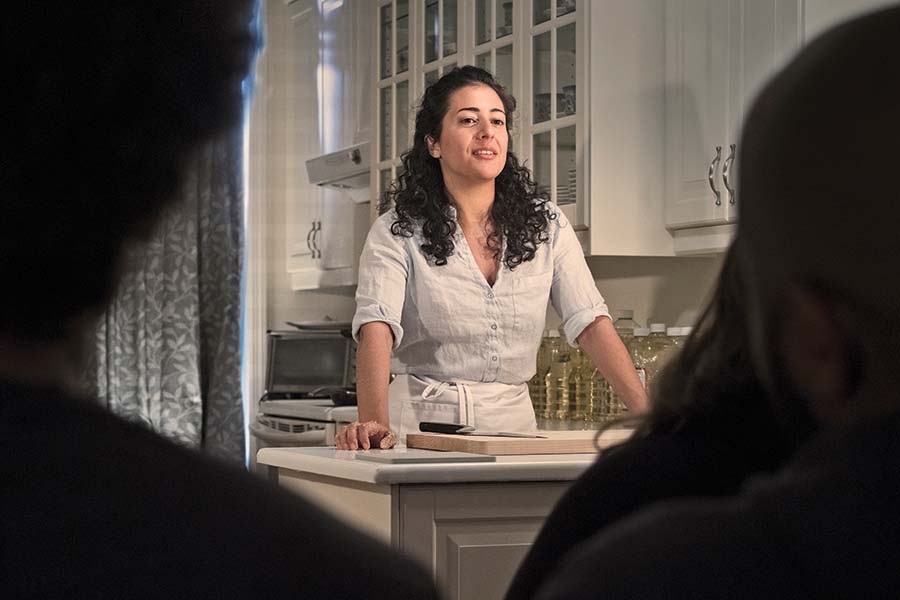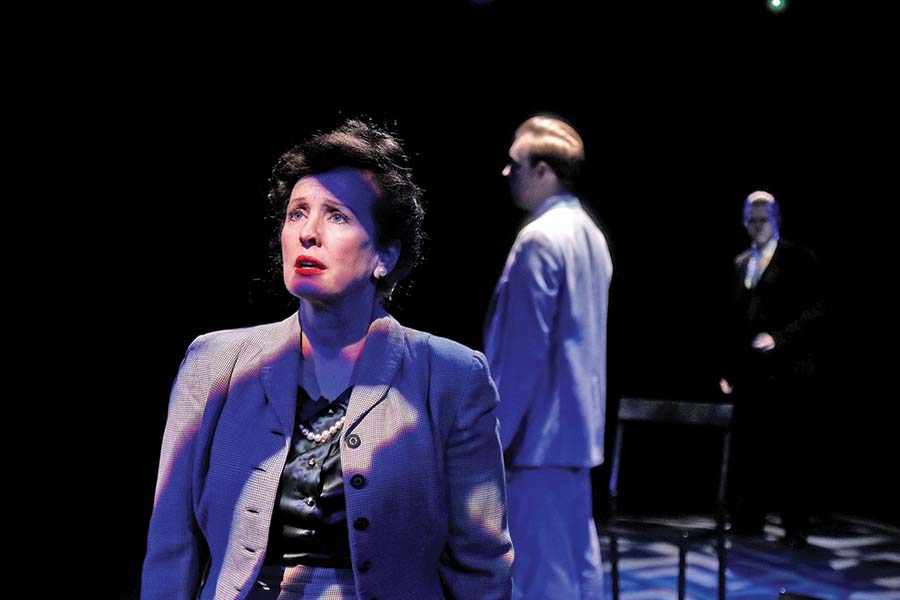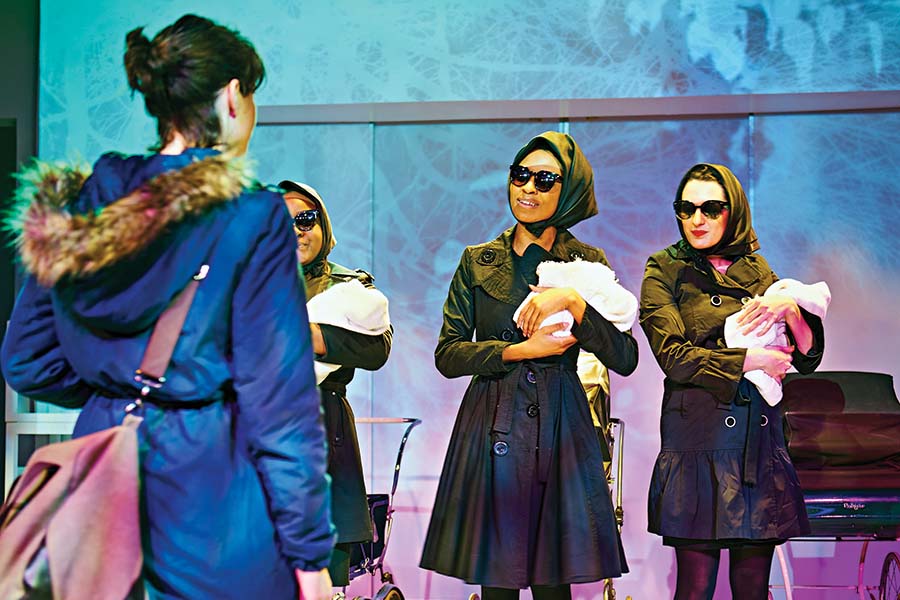Theatre Communications Group’s Theatre Facts 2017 observes that, with the recession largely behind them, U.S. theatres in 2017 were in a position of relative stability. “FY17 was more or less business as usual,” said executive director Kate Piatt-Eckert of Steep Theatre Company in Chicago. Naturally, not every company in the country was in this position, but that relative stability meant some theatre organizations could carve out time to address debt reduction, engage in strategic planning, and prepare for upcoming changes.
Theatre Facts 2017 is the 38th edition of TCG’s annual in-depth industry report based on data from the TCG Fiscal Survey. Written by Zannie Giraud Voss, Glenn B. Voss, and Lesley Warren of SMU DataArts, and Ilana B. Rose and Laurie Baskin of TCG, the report gives theatremakers and theatre lovers the opportunity to examine financial, performance, and attendance data for the U.S. professional nonprofit theatre field from three perspectives:
The Universe section offers a broad overview of the U.S. professional not-for-profit theatre field in 2017, which included an estimated 1,759 organizations.
The Trend Theatres section explores changes over time, with longitudinal analysis of the 129 TCG member theatres that participated in the Fiscal Survey yearly since 2013; there’s also data for 94 theatres that participated yearly since 2008.
The Profiled Theatres section provides a detailed examination of data from all 173 TCG Fiscal Survey 2017 participants (TCG member theatres that provided data for fiscal years concluding anytime between Oct. 31, 2016, and Sept. 30, 2017) and breaks those theatres into six budget groups, based on annual expenses—from Group 1 (annual expenses of $499,999 or less) to Group 6 (expenses of $10 million or more).
In conjunction with the release of Theatre Facts 2017, which can be found in the Research section of tcg.org, we spoke with 12 managing leaders from a diverse group of theatres across the country about stabilizing and strengthening their organizations, growing payroll and staff, developing audiences, investing in fundraising, and how their location affects their expenses. All references to Trend Theatres denote the five-year analysis, unless otherwise indicated, and all figures are adjusted for inflation.

A Year for Planning and Taking Stock
The relative stability experienced by the U.S. professional not-for-profit theatre field during the five-year period between 2013 and 2017 is reflected in the Change in Unrestricted Net Assets (CUNA), which represents total unrestricted income minus expenses. Basically, CUNA is the figure that indicates whether or not an organization ended a year in the black or the red. In each of the five years, average CUNA was positive, with more than half of the Trend Theatres ending their fiscal years in the black. Earned income, too, was at its highest point in 2017, growing 11.4 percent from 2013.
“FY17 was the year we really felt stable enough to prepare to launch the growth in FY18,” said Phil Santora, executive director of TheatreWorks in Palo Alto, Calif. “Coming off the recession and the upheaval in the arts organizations in Silicon Valley, to get ourselves to a point where there’s restored confidence throughout the company was something we were able to attack, and that’s exciting. It’s not so much a numeric thing as sort of an emotional ‘we feel stable enough to embrace some larger, more challenging projects.’”
TheatreWorks also spent FY17 putting together a succession plan, anticipating the retirement of their founding artistic director, Robert Kelley, in 2020. This meant working with the board and examining four succession case studies from around the country to determine TheatreWorks’ values and crystallize their own process for making the leadership transition.
Pennsylvania’s Open Stage of Harrisburg contended with their own leadership change: founders Donald and Anne Alsedek announced their retirement, which began at the end of FY17. Producing artistic director Stuart Landon speculated that the retirement announcement caused a dip in education program income, as Anne Alsedek was a big draw for students. Open Stage’s ticket income, however, grew remarkably from FY16. Landon attributed this, too, to the retirement of the founders as well as the return of A Christmas Carol to their stage.
While TheatreWorks was planning a transition and Open Stage was managing one, the Play Company in New York City had just completed a transition. PlayCo’s Robert Bradshaw began his tenure as managing director on the first day of FY17. Bradshaw had worked in different capacities at the theatre, so moving into his new position didn’t require the same intensive planning as the transitions at TheatreWorks or Open Stage. Regardless, leadership changes are tricky things. Leaders develop strong relationships with funders, supporters, board members, audience members, and others. Those relationships often translate into monetary support—whether in donations, grants, or ticket sales—so it makes sense for theatre leaders to invest time and resources into managing such critical transitions.
FY17 marked the 40th anniversary season for Penumbra Theatre in St. Paul, Minn. In addition to transitioning artistic leadership from founder Lou Bellamy to Sarah Bellamy—who became co-artistic director in 2014 and is Lou Bellamy’s daughter—they promoted their brand refresh and developed a new predictive marketing model. Penumbra was also the feature of a special exhibit at the Minnesota History Center exploring the history of African American artistic expression. These strategic tactics and heightened visibility resulted in increased ticket sales and first-time ticket buyers, reported managing director Amy Thomas.

Eliminating Debt and Building Cash Reserves
Theatre Facts shows that 40 percent of the Trend Theatres were engaged in some type of capital campaign during 2017. While many of those campaigns were related to facilities and equipment, many were also working to build endowment funds and funds related to artistic/programming, operating/technology, and other purposes. Solving financial and structural problems and creating opportunities for risk and growth were top of mind for many of the theatre leaders featured in this article. For Santora at TheatreWorks Silicon Valley, FY17 was all about “doing financial stabilization work,” which resulted in wiping out $1.1 million in debt. Reducing their debt thus dramatically set up TheatreWorks to try more ambitious projects in the following season.
Arts Center of Coastal Carolina on Hilton Head Island, S.C., also made debt reduction a component of their recent capital campaign, said president and CEO Kathleen Bateson. The theatre was hard hit by the recession and, as a result, had to put a portion of their education department on hiatus and enact forced furloughs for some other staff members. To date, they’ve raised $1.75 million toward debt reduction and recovery. The campaign also raised funds for facilities and equipment.
The American Repertory Theater (ART) in Cambridge, Mass., maintains what they call “risk funds,” two board-managed endowments comprising royalty payments the theatre receives for commercial productions that originated with them, said executive producer Diane Borger. Meanwhile, Steep Theatre in Chicago received a cash reserve challenge grant from the Gaylord & Dorothy Donnelley Foundation, reported Piatt-Eckert. “We raised $10,000 in new and increased individual gifts, which was matched by the foundation to establish a board-designated cash reserve,” she said. “This reserve will help us manage the unexpected for years to come.”
Though the value of cash reserves for the Trend Theatres decreased slightly from 2013, the overall number of Trend Theatres reporting cash reserves increased from 52 in 2013 to 59 in 2017. The value of Trend Theatres’ endowments increased annually for a total growth of 36 percent over the five-year period. While these are both positive developments, Theatre Facts also reveals that working capital—the unrestricted resources available to meet day-to-day cash needs and obligations—was negative in each of the five years, as was the working capital ratio, which relates working capital to total expenses and indicates how long a theatre could pay its short-term obligations based on these resources. These findings mean that the average Trend Theatre was regularly experiencing cash-flow crunches and borrowing funds internally or externally to meet its daily operating needs. There is also a flip side to the positive news about CUNA noted earlier in that, annually, between 41 and 49 percent of the Trend Theatres did not generate enough income to cover their expenses.
Payroll Going Up, Up, Up
“Everything here is made by a body,” said Arts Center’s Bateson. “This is what it takes.” She was describing her philosophy on the need for competitive compensation for artists, production and technical personnel, and administrative staff. Seventy-eight percent of Arts Center’s fixed expenses go to people. Bateson’s sentiment was echoed throughout the interviews with these theatre leaders: People are important, and we need to invest in them.
Theatre Facts demonstrates this financial commitment, as total payroll growth rose 15.5 percent from 2013, accounting for 2.3 percent more of Trend Theatres’ total expenses over the five-year period. This growth wasn’t solely due to raises and increasing benefits costs. From 2013 to 2017, the average number of paid personnel grew every year, from 245 to 290.
Increasing artist compensation was a prevalent theme in talking with theatre leaders. Piatt-Eckert noted Steep’s commitment to raising artist pay. Managing director Paula Tomei of South Coast Repertory in Costa Mesa, Calif., noted that 72 percent of the theatre’s total expenses go to compensation, and “of that amount, 37 percent was artistic compensation—both staff and guest artists.”
Part of the spike in compensation can be traced to recent movements and legislation impacting minimum-wage laws and overtime regulations. Though PlayCo had already crafted a plan in 2014 to raise compensation across the board quite significantly, that legislation redirected some of the focus onto actors and stage managers. PlayCo’s ultimate goal is to provide a livable wage for each person it hires or contracts—even though, Bradshaw joked, “I have yet to have someone explain to me what ‘livable’ means in New York City in a viable way.”
Even without minimum-wage laws, plenty of theatre leaders are working hard to provide compensation commensurate with the work that artists perform. The Clarence Brown Theatre in Knoxville, Tenn., looks to the TCG Salary Survey for guidance in setting compensation, and as a member organization of the League of Resident Theatres, they have fee schedules. But “99 times out of a hundred, we pay more than the LORT minimum on all of those scales,” said managing director Tom Cervone. “I want to make sure all artists are compensated fairly equitably. We try to do what we’re able to do in the market we’re in.”
From 2013 to 2017, Trend Theatres on average engaged 19 percent more paid artistic personnel (including staff and contracted artists), starting at a low of 120 in 2013 and moving to a high of 143 in 2017. The subsequent payroll growth was 13.7 percent and accounted for 18 to 18.5 percent of total expenses every year.
Lest we forget the other folks who make theatre happen: Administrative payroll rose, too—16.2 percent over the five years—along with the overall average number of full-time/part-time administrative personnel (including marketing, education, development, and front of house). Production/technical payroll also grew 16.8 percent from 2013 to 2017. This growth in payroll reflects the overall rise of the cost of standard of living and the cost of doing business, but it also reflects theatres’ investment in their people.

Location, Location, Location
It’s no secret that where your organization is located affects your expenses: real estate, taxes, city and state arts funding, systemic issues that affect economic health and opportunities, rent. And that’s all before you pay your people and make your art. The other thing that isn’t a secret is that expenses for theatres are rising across the board. Theatre Facts reports that total expenses were 10.8 percent higher in 2017 than in 2013, and every expense area grew over time, surpassing inflation, except for non-personnel general artistic and production/technical expenses.
As discussed earlier, payroll across the board has gone up, which accounts for a good chunk of that increase. But theatre leaders interviewed for this article pointed to several other factors that have them spending more in their budgets, namely the cost of living where they’re located.
“Real estate impacts almost everything we do,” said TheatreWorks’ Santora. Living and working in Silicon Valley means grappling with those staggering prices. Bringing in and housing out-of-town artists has been extremely challenging, as has been attracting, retaining, and replacing staff when there’s turnover. “For an artist, making a life in the Bay Area is becoming increasingly prohibitive,” he added. “Life here is unbelievably expensive, and everyone knows it. We’re more expensive than Manhattan.” Not only is it expensive, it’s also getting crowded. Santora said staff members were once able to live in Oakland—relatively cheaper and not too far a commute—but traffic has made things so congested that that’s no longer possible.
South Coast Rep’s Tomei echoed Santora’s concerns. “We benchmark all salaries annually against industry norms and also have to take into consideration the cost of living in Southern California (which is high!) when budgeting,” she said. “Attracting and retaining the finest artists and staff depends on making this a top priority.”
Physical space is at a premium too. PlayCo is part of the 39 percent of Trend Theatres who in 2017 rented performance space. As venues renovate their facilities, they pass on those costs to renters, who can also face restrictions to access and usage of the space. “Finding the spaces we want and the spaces that are in good locations is becoming much more expensive and hard for companies of our size,” said Bradshaw.
Not only does PlayCo rent performance space, they also rent their administrative offices. Every time the lease renewal comes up on their office in Midtown, the landlord wants to increase rent by 70 percent, Bradshaw reported. “I managed to talk them down to a 25 percent increase. But if our staff continues to grow, we are going to outgrow the physical space here, so we’ll have to figure out something when our new lease comes up in three or four years.” Those rising rent prices aren’t likely to go away. Between 2013 and 2017, expenses on rent or debt service on facilities rose 4 percent, a trend that’s sure to put some theatres in tight places.
Arts Center of Coastal Carolina’s home of Hilton Head Island is surrounded by water in a humid, salt-air climate, which means maintenance on their building, which they own, can take up 9 to 10 percent of the total operating budget. Beyond that, their location means “it’s very difficult to staff here,” Bateson said. “This is an expensive place to live. So for beginners or early-career people, it is very, very hard.” As far as professional theatre goes, the island supports little beyond the Arts Center and another company, Lean Ensemble Theater, so there’s little possibility of cobbling together a living from a variety of theatres the way people can in other communities.
Being on Hilton Head Island also left Arts Center vulnerable to FY17’s Hurricane Matthew, which led the theatre to evacuate the cast of Pride & Prejudice to a hotel away from the destruction (they ended up doing a few performances for hotel guests). “Every day was a new day,” Bateson said. The theatre lost 14 performances to Matthew along with any potential revenue. They had to move their fundraising golf tournament. Individual contributions to the theatre went down as supporters repaired damage to their properties, and Arts Center spent $200,000 of their own to clear trees and make repairs.
While Hurricane Harvey struck Houston just after the end of Main Street Theater’s FY2017, it offers another case study of the impact of natural and other types of disasters. Main Street Theater didn’t experience any of the flooding that impacted other organizations in Houston, but they had to cancel some of their theatre for youth performances, losing $90,000 in revenue. Much of the initial Harvey relief funds weren’t funneled to arts organizations—“The arts are not high priority,” said executive artistic director Rebecca Greene Udden, “until you’ve dealt with people’s housing and health and everything else”—but in FY18, Houston foundations did bump up funds to their grantees to compensate for the hit they took.

Building a Loyal (and Diverse) Audience
Many of the theatre leaders interviewed for this article described working to grow and diversify their audiences to spread the impact of theatre and to expand their communities. How can theatres retain already loyal audience members while inviting in new ones?
South Coast’s Tomei said participation in community events was key for meeting people outside of their typical audience demographics. “These include everything from participating in Día de los Muertos celebrations in the Latinx community (to engage around Destiny of Desire by Karen Zacarías) to a pre-show chat and information sharing event for families affected by autism and the Indian American community (for Orange by Aditi Brennan Kapil),” she said. At Geva Theatre Center in Rochester, N.Y., executive director Christopher Mannelli said their 28 education programs reach and serve a variety of groups throughout the community. The findings in Theatre Facts underscore the reach of education and outreach programs, showing that in 2017 Trend Theatres served an average of 19,743 people through these programs, down only slightly from the five-year high in 2016.
In addition to attending community events, adding events outside of the mainstage season has been an effective strategy for Cleveland’s Karamu House in inviting new people into the theatre. Since he arrived at the theatre, president and CEO Tony Sias began programming poetry/spoken-word nights, comedy acts, and musical concerts. “We have begun to use that as bait on the hook for those individuals who might not be theatre patrons,” Sias explained. He’s seen results: About 60 percent of spoken-word night audiences are under 30 years of age.
Karamu House is not alone in understanding the value of these kinds of events. Theatre Facts reveals that there were 10.9 percent more performances of booked-in events—theatre, dance, film, or other events that a theatre presented but did not create and were not offered as part of a series—in 2017 than in 2013, which attracted 13.3 percent more attendees. Interestingly, ticket income from booked-in events was 8 percent lower in 2017 than in 2013, suggesting that the average ticket for these events got cheaper.
Sias has also worked to broaden the kinds of mainstage productions the theatre produces. While the mission of Karamu House is to honor the African American experience in all of its programming, Sias explained that “there are so many ways” to honor and reimagine that focus. “So it’s looking at scripts and stories that are inclusive and diverse in characters, but still carry the message and tell stories that are as diverse as we are as black folks,” he said. “The African American experience is a part of the American experience. So we’ve broadened our lens in terms of the kinds of stories we tell and how we tell those stories.”
Several other theatre leaders discussed strategic programming and/or marketing to appeal to demographics they’d like to see in their audiences. The New Works Festival at TheatreWorks is a natural fit, said Santora. “This is an area that loves creative process. There are people around here that say, ‘If you haven’t failed dramatically at least once, you haven’t had a life!’” It doesn’t hurt that tickets for the festival are priced at $20 for one reading and $49 to see all four plus access to a Meet-the-Artists panel. “Economics should not be a reason you can’t come to TheatreWorks,” Santora said.
In 2017 the average single-ticket price offered by Trend Theatres (including discounts) was $38.63, a five-year high. Plenty of companies offer single tickets at lower price points or make discounts and specials available—for students, seniors, military, etc.—to attract certain audiences. TheatreWorks also offers a kind of twofer package: If you buy a ticket to one of their buzzier productions, you can get a ticket to a musical that’s in development, say, for an additional small cost. This invites audience members to engage again with TheatreWorks and gives smaller productions more robust audiences.
Strategic pricing can be key to audience development. “One of our core values is that we make our programs affordable and accessible to as many audiences as possible,” said PlayCo’s Bradshaw. “We know that even a low price point can be a barrier for certain communities, especially in the New York City community, and so we do our best to try and break through those barriers as much as possible.” That philosophy is especially important in New York, like other cities with numerous theatres, and also because PlayCo’s productions are often uniquely culturally specific. To that end, PlayCo’s staff works closely with community partners to engage and reach out to communities they think will be interested in given productions. Bradshaw knows that PlayCo’s main audience demographic is theatre’s white whale: 40 percent of their audience base is in the 25- to 35-year-old range. “I almost fell off my chair!” he enthused.
Getting specific with programming and offerings has been effective for Main Street Theater as well. In FY17, the theatre partnered with the University of Houston to offer American Sign Language-interpreted and -shadowed performances for their theatre for youth productions. They also started incorporating sensory-friendly performances for children on the autism spectrum and their families into theatre for youth productions. Also, both of Main Street’s venues are equipped to provide audio description. Udden reported, “People who needed it, love it. We’ve gotten a lot of positive response from the audience” attending those performances.
Penumbra Theatre “expanded community involvement through our Access Wednesday program, engaging with a variety of local nonprofits by providing $5 tickets for main stage productions,” said Thomas. The communities served by those nonprofits are diverse in race, ethnicity, age, ability, socioeconomic status, and cultural interest, she added, and Penumbra grew their partner organizations from 29 to 107 from FY16 to FY17. This resulted in an 86 percent increase in attendees at Access Wednesday, from 1,247 to 2,315.
The Tale of Ticket Sales
For subscriptions it’s the best of times, it’s the worst of times. While subscription models may be evolving and changing, the notion of reserving season tickets in advance definitely isn’t. Average subscription income was at its highest five-year level in 2017 after bouncing back from a low in 2015, though that income didn’t keep pace with inflation. What’s more, the average number of subscribers fell 11.2 percent from 2013 to its lowest point in 2017. So while subscriptions are alive—and still the second-greatest source of earned income for theatres—the average Trend Theatre has seen them losing ground.
Though Main Street Theater enjoys an average of 600-650 mainstage subscribers every year, Udden realized that “this audience is shrinking,” and initiated a campaign in FY17 to encourage more folks to buy subscriptions—hopefully full-price. About 30 to 40 percent of their mainstage subscribers go for the preview package, which is cheaper. Growing those numbers is important: As generations and demographics shift, so do practices and tastes. But the renewal rate for subscriptions ranged from 73.6 percent to 74.8 percent throughout the five-year period—not too much variance. These figures, combined with the decline in subscriptions sold, suggest that theatres haven’t significantly been acquiring new subscribers.
Single-ticket sales, on the other hand, are on the rise. Single tickets continued to be the biggest source of both earned income and total income annually for Trend Theatres, increasing by an average of 12.3 percent from 2013. Not only that, but the average number of single tickets sold increased by 2.3 percent. But individual theatres did see some gains in subscriptions. Subscriber numbers at Karamu House went from 200 to 250, reported Sias, and at Geva Theatre Center subscriptions increased 5 percent.
Meanwhile at Clarence Brown Theatre, Cervone said, “On the earned income side, it was one of those years when everything did better than expected, and, in some cases, by a lot.” Cervone credited this development to programming the musical Violet at the start of the season, and the success of their final production of the season, Around the World in 80 Days, which made 120 percent of its ticketing goal. At Main Street Theater in Houston, ticket sales accounted for 65 percent of earned income.
Special productions—non-subscription holiday productions—can play a significant role in ticket sales, something many theatres clearly understand. Theatre Facts reveals a 3.1 percent increase in the number of special production performances from 2013 to 2017, with a corresponding increase of 2.6 percent in attendance. Cervone noted that attendance grows every year for Clarence Brown’s staging of A Christmas Carol—perhaps the most popular example of a special production—and South Coast Rep’s Tomei said ticket sales for their Christmas Carol make “approximately one-third of the overall single ticket goal.”
So theatres could go all in on promoting and courting single-ticket sales, but the positive cash flow and relationships that advance ticket sales provide—and that subscriptions guarantee—are too valuable to abandon. Instead, theatres are reimagining subscriptions. To adjust subscription models to reflect changing tastes, Steep Theatre created the Steep Pass in FY16. The Steep Pass “lets folks start their four-show subscription at any point during the year,” Piatt-Eckert explained. “This has helped us to engage single-ticket buyers when they first discover Steep.” Since the Steep Pass launched, Piatt-Eckert said they’ve seen steady growth in sales. This is encouraging evidence that audiences are still ready to embrace subscription-style ticketing.

Investing in Development
“It takes a lot more to raise less than even five years ago,” said Borger. “A high degree of cultivation/stewardship is critical from the $50 to $50,000 supporter to secure upgrades and renewals…Making sure a donor feels appreciated is critical.” While Theatre Facts reveals that it cost Trend Theatres about the same amount in development expenses (including personnel) to earn a dollar of unrestricted contributed income in 2017 as it did in 2013, Borger’s statement addresses the investment of time and relationship-building that accompanies development work. But that investment makes sense: Theatre Facts shows that the greater growth in total unrestricted income over total expenses from 2013 to 2017 was driven more by contributions than earned income, which can be unpredictable. So it’s a no-brainer that theatres would give more attention to the people and expenses that would result in contributed income.
According to Theatre Facts, non-payroll development expenses alone increased by 21.4 percent from 2013 to 2017, with growth in every year of the period. In conjunction with these expense increases, growth in unrestricted contributed income went up by 17.2 percent. Theatres are seeing a payoff as they allocate their resources to development.
Penumbra’s decision to invest heavily in development during their anniversary year bears this out. Individual contributions that year exceeded goal by 16 percent and government grants by 25 percent, said Thomas. The theatre’s 40th anniversary gala, which also celebrated the transition of artistic leadership, “raised an unprecedented $560,000.”
Meanwhile at PlayCo, Bradshaw reported that the financial success of their FY17 productions, combined with robust individual support, enabled the theatre to increase their expense budget and hire a dedicated development director. While only the search for this position occurred in FY17—with the new staff member beginning work at the start of FY18—the organization’s decision to invest resources in the position suggests a desire to concentrate on fundraising and to increase contributions from individuals.
Other theatre leaders have taken note of the success of allocating increased resources toward development. Main Street Theater’s Udden reported that they received a grant at the end of FY17 to fund a dedicated full-time development staffer. Landon of Open Stage reported that it wasn’t until FY17 that “development, which had never really existed anywhere outside of a board committee, was finally put on my plate.” This was the year Landon went full-time at Open Stage, and he was grateful there were some existing systems and relationships that guaranteed a certain level of funding.
Clarence Brown’s Cervone explained that Knoxville has what people call the Three Pillars, the city’s long-standing cultural institutions: Knoxville Museum of Art, Knoxville Opera, and Knoxville Symphony Orchestra. The decision at Clarence Brown Theatre to move their part-time development staff member to full-time was informed by their wish to make the theatre the fourth pillar and to subsequently grow their individual contributions.

Foundations Stepping Up
Theatre Facts reveals that individuals (trustees and non-trustees) were the biggest source of unrestricted contributed income for Trend Theatres. Over the five-year period, their average combined individual contributions rose 23 percent and supported 2 percent more expenses. The report also reveals another entity growing its support: foundations. Average foundation funding was 13.7 percent higher in 2017 than in 2013 and covered 0.2 percent more of expenses in 2017 than it did in 2013.
This is nothing to sneeze at. The funding landscape is increasingly strained—as mentioned above—and foundations are a critical piece of the puzzle, especially for smaller theatres, as shown in the Profiled Theatres section of Theatre Facts. Landon praises the foundation grants that Open Stage—a theatre with an annual budget of less than half a million dollars—receives, especially from the Shubert Foundation. “Without them, I just know we wouldn’t be around anymore,” he said. Even though Open Stage has always had solid leadership and fiscal oversight, the funding from Shubert has been critical.
Bateson reported that foundation grants for Arts Center are getting stronger, mainly because the theatre’s activities and foundation funding priorities are in alignment. “The foundations we’re working with are about participation, community development, community involvement, and—particularly here in this area—preserving the Gullah culture,” Bateson explained. “I would be doing those things anyway. And we’re doing them and getting them funded.”
The numbers bear out Bateson’s assertion about foundation funding strength. Trend Theatres saw their average number of supporting foundations go from 19 in 2013 to 21 in 2017. Sixty-two percent of theatres saw their foundation support grow over the five-year period.
That’s been the case for the ART. Borger said foundation giving increased by 15 percent from FY16 to FY17. She credits this to “gifts ranging from $2,500 to $5,000 from small local or family foundations to grants of $200K or more from major national or regional foundations.”
Bradshaw saw PlayCo’s foundation funding go up annually or biannually five to six years in a row, a cumulative increase of roughly 25 percent. Bradshaw credits the relationships PlayCo has developed with foundations and the dedicated program officers who understand the theatre’s work. While PlayCo receives significant funding from foundations that are committed to funding theatres and the arts—Shubert, Gilman, and Mellon—Bradshaw has plans to approach foundations who might be interested in project-specific funding or a partnership around a certain culture or a social justice issue.
Just as important as growth is consistency. In FY17, Main Street Theater not only saw decreased government and corporate funding, but they were also still operating under a deficit accrued from moving into and renovating new venues in FY15. “Once you start on a season, you’ve got all these commitments, you’ve got to do these shows. It’s going to cost this money,” Udden said. “If grants don’t come in or tickets don’t sell, you’re just kind of stuck with it.” Luckily, Main Street Theater continued to receive important foundation funding, helping push them through the year.
Even in the best of times, running a theatre involves daily challenges, difficult decisions, and an element of unpredictability. From 2013 through 2017, though, Theatre Facts 2017 shows that the Trend Theatres were on pretty solid footing. They witnessed increases in single-ticket sales and in contributions from individuals and foundations, added staff and increased payroll, and strengthened investments and facilities through capital campaigns. The estimated Universe of 1,759 professional not-for-profit theatres contributed nearly $2.6 billion to the U.S. economy in 2017. Those theatres attracted around 44 million audience members and employed 147,000 artistic, production/technical, and administrative personnel. Theatre leaders reported efforts to strengthen their organizations by eliminating debt, building reserves, thoughtfully navigating leadership changes, developing audiences, and investing in fundraising personnel and partnerships. As Clarence Brown’s Cervone expressed, “We just have to keep it up and not forget about tomorrow.”
Theresa J. Beckhusen, a writer and editor based in the Twin Cities, is a frequent contributor to this magazine.


